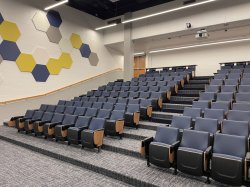Space Assessment Study
Posted in: Construction News, Facilities Updates, Public Service Announcements

Montclair State University Space Study
Answers to Frequently Asked Questions about Utilization Sensors
As part of a space study taking place this fall and spring, sensors will be deployed for short periods to better understand trends in how we use space today and ultimately help us maximize the impact our real estate assets have on faculty, staff and students in the future. The use of sensors, however, naturally raises questions. To be transparent, we are sharing answers collectively through FAQs below. If you have additional questions, please don’t hesitate to reach out to us.
Frequently Asked Questions
Q: What data is being collected by the sensors?
A: Only occupancy data is being collected. For small spaces like workstations and offices, occupancy is simply whether one or more people are present at set intervals. For larger communal spaces like classrooms and meeting rooms, the number of people present is also collected.
Q: What data will not be collected by the sensors?
A: No personally identifiable data is being collected. In addition, data such as keycard swipes to enter/exit a space and network usage will not be collected.
Q: How can we guarantee that our privacy is not being compromised?
A: The sensors are only capable of detecting whether people are present or not, and are only capable of recording and transmitting numerical occupancy data. They have no ability to record images, audio, or any other information about activities in a space. The company providing the sensors – Freespace – meets stringent global data privacy and security standards, including Europe’s General Data Protection Regulation and the ISO 27001 standard.
Q: What types of sensors are being used and how do they work?
A: All sensors being deployed use passive infrared technology, similar to sensors used in some light switches to automatically turn on lights on and off. The sensors do not scan spaces but rather detect heat signatures coming from people. In offices and workstations, simple infrared sensors will be used that can only tell when a person is close to the sensor. They are primarily placed under desks to be out of the way but still close enough to be triggered when someone is at the desk. Being under the desk also helps to eliminate incidental activity, as when custodial staff may be passing through to empty trash. In conference rooms, more sophisticated infrared sensors are used that can tell how many people are present based on multiple heat signatures. In larger classrooms and labs, infrared sensors are used at egress points to track how many enter and exit the space over time.
Q: Why was my space selected?
A: Since looking at every space in every existing facility on our campuses was impossible, we chose to look at the four most-populated academic and administrative buildings on campus. In the fall we are focusing on office space and in the spring on learning, research and study spaces.
Q: How will the data be used?
A: Patterns of occupancy for classrooms, conference rooms, lounges, labs, offices and workstations will be analyzed at the building level to determine trends related to space use. Findings, combined with input from faculty and staff via a workplace survey, will be used to explore how we can most effectively support our growing needs.
Q: Who has access to the data?
A: Only Freespace and Gensler, the teams managing the study, will have direct access to raw data. In addition to meeting global data security and privacy standards, both have contractual obligations to follow our data policies and maintain confidentiality. Processed data will be shared with the real estate planning team in Facilities to understand findings and their implications, which will be shared with the Montclair State community through the various shared governance groups.
Q: What happens to collected data once the study is done?
A: Raw data will be stored by Freespace and Gensler for a limited time following the completion of the study to allow for additional analysis and validation if necessary. After that point, raw data will be deleted.
Q: What is the timing?
A: Data collection in office, workstations and conferences will end after a four-week period in October. New sensors will be installed in classrooms, labs and lounges in the same buildings over winter break, and those sensors will collect data for four weeks ending in February.
Q: Can space reallocation decisions be made prior to the completion of the space assessment study?
A: In general, no space relocation decisions will be made prior to the completion of the space assessment study. This is to ensure that all space reallocation decisions are data-driven, objective, and reflect our short and long-term space utilization strategy.
Sensor Specifications
TIM Sensor
ONE Sensor
FLO Sensor
